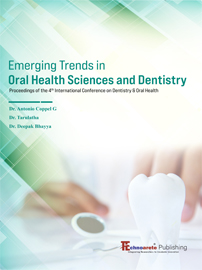


Resident of Oral Medicine, Faculty of Dentistry, Universitas Indonesia, Jakarta, 10430, Indonesia
Resident of Oral Medicine, Faculty of Dentistry, Universitas Indonesia, Jakarta, 10430, Indonesia
Corresponding Author: anandina.irmagita74@ui.ac.id
Postgraduate, Chettinad Dental College and Research Institute, Kelambakkam, Chennai
- Sialorrhea is a common problem in patients with Parkinson’s Disease (PD), that estimated up to 78% among them. This condition causes medical problems, mental and psychosocial distress. Managing sialorrhea requires a multi-aspect treatment, involving pharmacology and non-pharmacology treatment. This case report aims to elucidate the non-pharmacological treatment challenges of sialorrhea in PD. A 73-years old male came to Oral Medicine Clinic of Universitas Indonesia Dental Hospital, complained of continuous saliva drooling from his mouth since 2 years ago after a full mouth extraction, accompanied with uncontrolled masticatory muscles movement around the mouth. He underwent partial denture treatment, which was postponed due to pandemic, thus disrupting his nutritional intake. He was under routine medication for PD since 2003 and hypertension since 2007. Extra oral examination showed masticatory muscular deconditioning, dry and desquamated lips. Intra oral examination revealed uncontrolled movement of the tongue, atrophic dorsum papillae, and clear saliva. There was a 5 mm single round-shaped ulcer on lower right labial mucosa of 43. An unstimulated salivary flow rate examination showed a normal result. The working diagnosis was sialorrhea in PD and suspected traumatic ulcer. Non-pharmacological therapy was chosen to manage this case by continuing denture treatment and practicing swallowing saliva periodically, while chlorhexidine gauze was used for the ulcer. Nevertheless, the motivation of the patient and inter professional teamwork become the challenging points in the case management where dentist also plays an important part.
[1] Isaacson J, Patel S, Torres-Yaghi Y, Pagán F. Sialorrhea in Parkinson’s Disease. Toxins (Basel). 2020;12(11).
[2] Chou KL, Evatt M, Hinson V, Kompoliti K. Sialorrhea in Parkinson’s disease: A review. Mov Disord. 2007;22(16):2306–13.
[3] Sridharan K, Sivaramakrishnan G. Pharmacological interventions for treating sialorrhea associated with neurological disorders: A mixed treatment network meta-analysis of randomized controlled trials. J Clin Neurosci [Internet]. 2018;51:12–7. Available from: https://doi.org/10.1016/j.jocn.2018.02.011
[4] Sridharan K, Sivaramakrishnan G. Pharmacological interventions for treating sialorrhea associated with neurological disorders: A mixed treatment network meta-analysis of randomized controlled trials. J Clin Neurosci [Internet]. 2018;51:12–7. Available from: https://doi.org/10.1016/j.jocn.2018.02.011
[5] Miller N, Walshe M, Walker R. < p >Sialorrhea in Parkinson’s disease: prevalence, impact and management strategies< /p >. Res Rev Park. 2019;Volume 9:17–28
[6] Ball N, Teo WP, Chandra S, Chapman J. Parkinson’s disease and the environment. Front Neurol. 2019;10(March).
[7] Balestrino R, Schapira AHV. Parkinson disease. Eur J Neurol. 2020;27(1):27–42.
[8] South AR, Somers SM, Jog MS. Gum chewing improves swallow frequency and latency in Parkinson patients: A preliminary study. Neurology. 2010;74(15):1198–202
[9] Rozas NS, Sadowsky JM, Jones DJ, Jeter CB. Incorporating oral health into interprofessional care teams for patients with Parkinson’s disease. Park Relat Disord [Internet]. 2017;43:9–14. Available from: http://dx.doi.org/10.1016/j.parkreldis.2017.07.01
[10]Mao CJ, Xiong YT, Wang F, Yang YP, Yuan W, Zhu C, et al. Motor subtypes and other risk factors associated with drooling in Parkinson’s disease patients. Acta Neurol Scand. 2018;137(5):509–14.
[11]Karakoc M, Yon MI, Cakmakli GY, Ulusoy EK, Gulunay A, Oztekin N, et al. Pathophysiology underlying drooling in Parkinson’s disease: oropharyngeal bradykinesia. Neurol Sci. 2016;37(12):1987–91
[12]McDonnell MN, Rischbieth B, Schammer TT, Seaforth C, Shaw AJ, Phillips AC. Lee Silverman Voice Treatment (LSVT)-BIG to improve motor function in people with Parkinson’s disease: a systematic review and meta-analysis. Clin Rehabil. 2018;32(5):607–18.
[13]Morgante F, Bavikatte G, Anwar F, Mohamed B. The burden of sialorrhoea in chronic neurological conditions: current treatment options and the role of incobotulinumtoxinA (Xeomin®). Ther Adv Neurol Disord. 2019;12(January).
[14] Stiphout MAE Van, Marinus J, Hilten JJ Van, Lobbezoo F, Baat C De. Oral Health of Parkinson ’ s Disease Patients : A Case-Control Study. 2018;2018.
[15]. Jeter CB, Rozas NS, Sadowsky JM, Jones DJ. Parkinson’s Disease Oral Health Module: Interprofessional Coordination of Care. MedEdPORTAL J Teach Learn Resour. 2018;14(March):10699.